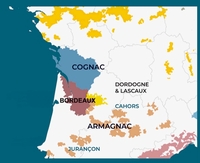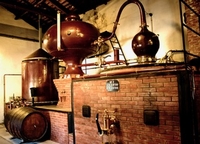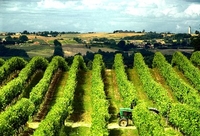
Let’s consider Cognac first. The Cognac district is centered around the eponymous town near the Atlantic coast of southwestern France, in the Charente-Maritime department. This is across the Gironde estuary from Bordeaux. Wine has been grown here for centuries, as the Charente was a source of wine and salt for northern European countries throughout the Middle Ages. It was the Dutch traders in the 17th century who created a market for "concentrated" wines as a way to make the often-rancid drinking water on their sailing ships more palatable. They concentrated the wine by distilling or "burning" it. The word brandy, which describes all spirits distilled from wine (and other fruits, for that matter) is derived from the Dutch word brandwijn, or "burnt wine."
As time went on, consumers discovered that the "burnt wine" became more pleasurable as it aged in barrel and the brandy of Cognac came into demand for its own distinctive character. Now, centuries later, the making of Cognac has been refined greatly and codified into law, but the spirit remains the most exalted in the world. Hugh Johnson, in the first edition of his World Atlas of Wine perhaps best captures the character of Cognac in words: "There is an uncanny fresh-grape sweetness about good Cognac, as though the soul of the vine has been etherealized and condensed. It makes you think not just of wine but of great wine – it has the same elusive complexity; the same raciness and excitement."
It is a unique combination or geology, grape selection, climate, distillation technique and barrel maturation that makes Cognac so special. The vineyards around Cognac are nearly all planted to Ugni Blanc grapes. The wine on its own is rather lean, mean, and acidic, but after two distillations and years of mellowing in barrel, it becomes what the world loves as Cognac. Geographically, Cognac is divided into six areas: Grande Champagne, Petite Champagne, and Borderies at the center surrounded by the Fin Bois, Bon Bois and Bois Ordinaires (or Bois à Terroirs). The best Cognacs come from the first four areas, with the lesser brandies from the Bon Bois and Bois Ordinaires used to add volume and depth to house blends. It is the chalky soils of Grande Champagne and Petite Champagne that yield the most aromatic and richly flavored spirits. Consumers can find Cognacs designated as Grande or Petite Champagne or sometimes Fine champagne, which is a blend of the two areas with at least 50% being Grande Champagne. On rare occasions, one can find bottlings from the Fin Bois and Borderies as well.

Once the base wine is made, distillation begins rather quickly, usually in late November of the harvest year. Freshness and purity of the base wine is essential for quality Cognac. Cognac is distilled in a pot still, basically a copper kettle with a condensation coil. The distiller must monitor the process carefully to ensure that only the finest middle portion of the distillate is retained. The first portion is too strong and impure, and the final portion is too weak. The first distillation yields a spirit called brouillis of about 30% alcohol. After three lots of brouillis are distilled, they are combined and distilled again. Once more, only the finest middle portion of the distillate, now called the bonne chauffe, is used. This raw spirit of about 72% alcohol is transferred to barrels of Limousin and Tronçais oak to mature. The barrels have been made from carefully selected oak that has been aged in open air for 3-5 years so that the wind and rain can wash away some of the bitter elements found in newly-sawn wood. It has taken nine barrels of base wine to obtain one barrel of bonne chauffe. As the spirit ages, it evaporates at a rate of 2-3 percent per year. This is known as the "angels’ share" and has a very real economic impact on Cognac production.
Cognac houses usually blend spirits from several districts to maintain a standard house style. The large Cognac houses also maintain large stocks of older spirits to keep their bottlings consistent from year to year. Cognac can be found under several designations. Three-star and VS Cognacs are ordinarily those that receive the least amount of age. They must age a minimum of two years, but in practice are usually aged longer. VSOP (for Very Special Old Pale) Cognacs must age at least four years in barrel but, again, are generally older. Other designations such as Vieille Réserve, Très Vieux, Napoleon, Extra and the like are given to even older blends. All of these must be at least six years old, and bottles labeled XO must age for ten years. It is wise to rely on the reputation of the maker of these special bottlings because house styles can vary widely.
Brands are very important in Cognac, especially for Cognacs that are sold outside of France. The four biggest houses of Martell, Hennessy, Courvosier, and Remy Martin sell eighty percent of the Cognac that is exported. There are dozens of other Cognacs available on the market, in many styles ranging from ethereal, delicately floral and spicy spirits to rich, intense spirits reminiscent of vanilla, nuts and maple. Tastes in Cognac, as with any food or beverage, vary with the taster. If you find a Cognac you like, use that as a base of exploration of similarly styled bottlings.

Armagnac is located only about eighty miles southeast of Cognac but produces a much different brandy. The sandy/clay soils of the Gascon hills on which the Folle Blanche, Ugni Blanc and Colombard grapes for Armagnac are grown lend a different character than the chalky earth of Cognac. The climate in Armagnac is warmer than in Cognac and there are different traditions in distillation and maturing of the spirits in Armagnac. All these factors lend good Armagnac a style that is quite different, but arguably no less appealing than that of Cognac.
There are three Armagnac regions – Haut-Armagnac, Bas-Armagnac and Ténarèze – with Bas Armagnac ranked as the best. Armagnac production begins with the fermentation of a very dry and tart base wine. Distillation of Armagnac, though, can either be in the same pot still as Cognac, or in a continuous still. In years past, the continuous still has been used in Armagnac production, since some continuous stills are portable and the Armagnaçais have not had the financial resources of their Cognac brethren to invest in the expensive pot stills. The distillate from a continuous still exits the still at 52-53% alcohol. This is much lower than the 72% level of Cognac. Consequently, there is much more flavor left in the spirit. Armagnac has also been traditionally aged in the local Gascon oak, a sappier wood than that of the Limousin and Tronçais forests. The result is that Armagnac is a fuller-flavored spirit than Cognac, often with more fruit aromas and distinct smoky, herbal and earthy nuances. Additionally, Armagnac has traditionally been sold younger than Cognac and has often exhibited a more fierce and fiery youthful character.
Much is changing in Armagnac in recent years, however, as economic conditions have improved for many producers. Many of the larger Armagnac houses now utilize the same pot still and double distillation techniques of Cognac. Also, since the supply of local Gascon oak has become depleted, Armagnac producers are using wood from the same Limousin and Tronçais forests as Cognac. The result is, not surprisingly, an increasing degree of similarity between the two brandies. The best examples will always be distinctive, though, because the differences in terroir – the combination of soil and climate – are reflected in the spirits. Winter is the perfect season to enjoy the rich aromas and flavors of Cognac or Armagnac. Either of these elegant spirits will add warmth to a long winter’s night.
